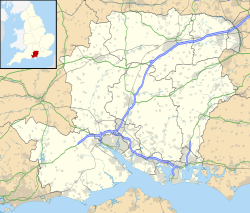Minley Manor
19th-century English country manor house From Wikipedia, the free encyclopedia
Minley Manor is a Grade II* listed country manor house, located within a Grade II registered garden, built in the French Gothic style by Henry Clutton in the 1860s with further additions in the 1880s. The Manor is situated 2 miles north of junction 4A of the M3 between Farnborough and Yateley in Hampshire, England and is situated in 80 acres (32 ha) of grounds.[1]
| Minley Manor | |
|---|---|
 Minley Manor | |
| Location | Minley |
| Coordinates | 51.317°N 0.820°W |
| Built | 1860 |
| Architect | Henry Clutton |
| Architectural style(s) | French Gothic |
Listed Building – Grade II* | |
| Official name | Minley Manor |
| Designated | 26 June 1987 |
| Reference no. | 1258061 |
Listed Building – Grade II | |
| Official name | Park and Garden |
| Designated | 7 December 1992 |
| Reference no. | 1001264 |
History
Summarize
Perspective
The current manor house was built in the French style by Henry Clutton between 1858 and 1860 for Raikes Currie, a partner in Glyn Mills' Bank and a member of the Currie family. Through this bank, they were early financiers of South Australia, a colony developed for the British government, and thus had some ties related to slavery and the colony.[2][3] During the next three years attention turned to the estate, with the creation of formal gardens around the house and a kitchen garden. The remainder was landscaped as pleasure gardens by F W Meyer,[4] working with the horticulturists Veitch & Sons of Exeter. On Raikes' death in 1881, his son Bertram Wodehouse Currie continued the development, employing Messrs Veitch to lay out a Winter Garden and extensions to the pleasure gardens, which included Hawley Lake, in the 1880s. The house was the birthplace of the British diplomat Sir Reginald Hoare in 1882.[5] Raikes' grandson Laurence Currie built a water tower, created a new complex of walled gardens and further extended the ornamental planting and woodland.[3]
The property passed to the War Office in 1934, initially for the Senior Wing of the nearby Staff College, Camberley.[6] It was used by the Royal Engineers, from 1971, as a brigade headquarters and then, from 1990, as an officers' mess for units at Gibraltar Barracks, which are located on the opposite side of the A327 Minley Road.[3]
In 2013, as part of the RSME-PPP project, the Holdfast consortium built a new officers' mess on the Gibraltar Barracks site. The Ministry of Defence part-funded this project from sale of the manor[7] which was sold to an international investor in November 2014.[8] The international investor submitted planning permission to change the use of the manor in to a five star hotel, spa, conference centre and Chinese culture centre.[9]
On the 22 October 2018 a large fire engulfed the water tower, part of the Minley Manor estate.[10] The owners of the estate, Strong Property (UK) Ltd, applied for planning permission to restore the tower in December 2019; however the request was rejected in April 2020 on the basis that the original iron water tank would not have been retained.[11]
In popular culture
One of the main features is a 600-metre Wellingtonia tree avenue, which was shown off to good effect in the 1969 movie Mosquito Squadron, where the manor house played the part of a French château used as a prisoner of war camp and factory for the V-1 flying bomb. The manor was also used as a location in the 2007 Victorian fantasy movie Stardust, starring Robert De Niro and Michelle Pfeiffer.[12]
The manor was used as the location for the external shots of Three Gables aka the titular Crooked House in the 2017 film Crooked House.[13]
The feature film Detective Pikachu, released in 2019, used the training bridge, also in the Manor's grounds, as the setting for the pivotal car crash.[14] The grounds of Minley Manor featured in the Netflix movie, Enola Holmes, released in 2020.[15]
References
External links
Wikiwand - on
Seamless Wikipedia browsing. On steroids.

